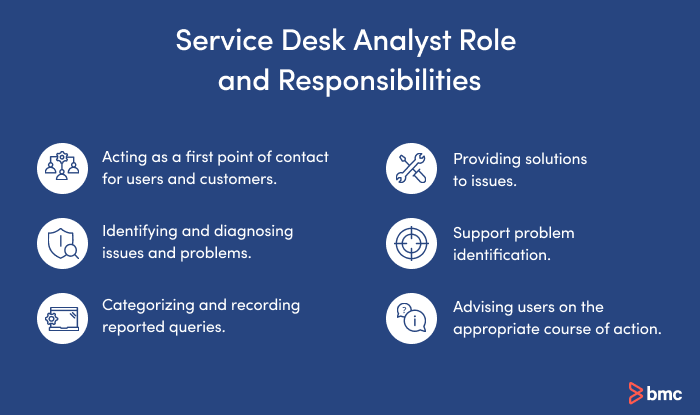When it comes to user perception of IT within an enterprise, there is no doubt that the service desk remains one of the major drivers of customer experience.
ITIL 4 defines the Service Desk as an entry and single point of contact for all users, where demand for incident resolution and service requests are received by the service provider. And while self-service portals and AI-powered chatbots are all the rage in handling user issues nowadays, there is still room for the human touch—particularly where empathy is required and complexity is encountered.
So, what do employees of a service desk do? Let’s look at the service desk support analyst role, including typical responsibilities.
Take IT Service Management to the next level with BMC Helix ITSM. ›
What is a service desk?
Think of a service desk or help desk as a center point or junction that functions as a place where technology users can get answers to questions, help with problems, and various technology or process needs satisfied. The idea of a “desk” is a metaphor for a single point of contact to the expertise that users need.
Service desk teams are typically organized to provide fast, effective resolutions for the most simple requests, with higher levels of escalation when a request needs the input of someone with a higher skill set. You will often hear the terms level 1, level 2, and level 3 service to describe the tiers of technical support a service desk organization may provide.
One of the challenges of managing a service desk organization is coordinating the right response to a user as quickly and as smoothly as possible. Handing over a user issue from one level to the next and on up can create a negative customer experience. Shift left approaches aim to reduce the number of layers a user must navigate, and swarming is a way to apply teamwork to resolve issues quickly.
What is a service desk analyst?
A service desk analyst is an IT professional who serves as the first point of contact between an end user and the company, working in a service desk or help desk environment.
Depending on the organization, formal titles for the service desk analyst job may be “service desk support analyst,” “help desk support analyst,” “help desk analyst,” “service desk specialist,” or simply “service/help desk support.” Some companies recognize a difference between service desk and help desk, but we’ll use the terms interchangeably here.
Though structures of service desks can change (see next section), service desk analyst roles have three main processes:
- User query/issue handling: Ensuring user queries or issues are captured, validated, and triaged for further processing.
- Communicating with users: Ensuring that various types of information are communicated to users through the appropriate channels.
- Optimization: Ensuring improvement of the two previous processes through analysis, reviews, and reporting, as well as through automation, competence building, knowledge sharing, and other organizational changes.
The service desk is one portion of your company’s overarching IT service management strategy. Read about additional career paths in ITSM.
What does a service desk analyst do?

A service desk analyst fulfills the role of the first point of contact when users require technical support. They must bring technical expertise and the ability to quickly assess a situation to resolve or escalate it. An effective help desk analyst will have a knack for interacting with people and a calm and effective presence.
Typical tasks of a help desk analyst include:
- Acting as a first point of contact for users and customers.
- Identifying and diagnosing issues and problems.
- Categorizing and recording queries
- Providing solutions to issues.
- Advising users on the appropriate course of action.
- Monitoring issues from start to resolution.
- Escalating unresolved problems to a higher level of support, if needed.
- Providing essential online security advice and support.
- Delivering customer service through multiple channels including human, digital, self-service, and automated.
- Logging issues and resolutions, tracking trends, and sharing insights with developers and product leaders.
Make sure to include the roles and responsibilities in your service desk analyst job description.
Service desk analyst career levels
Drawing from both the e-CF and the SFIA 7, here are common examples of service desk tasks based on the employee’s career level. Though these indicate levels within a traditional tiered framework, these competencies are applicable to most service desk approaches.
Level 1 (entry level) service desk analyst duties
- Service desk specialist receives and handles requests for service, following agreed procedures.
- Promptly allocates calls as appropriate.
- Logs incidents and service requests and maintains relevant records:
- Identifies and classifies incident types and service interruptions.
- Records incidents, cataloging them by symptom and resolution.
- Acts under guidance to record and track reliability data for services.
Level 2 service desk analyst responsibilities
- Systematically interprets user problems and identifies solutions and possible side effects.
- Uses experience to address user problems and interrogates databases for potential solutions.
- Escalates complex or unresolved incidents.
- Records and tracks issues from outset to conclusion.
- During change, acts systematically to respond to day-by-day operational needs, avoiding service disruptions and maintaining coherence to SLA and information security requirements.
- Responds to common requests for service by providing information to enable fulfillment. Promptly allocates unresolved calls as appropriate.
- Maintains records, informs users about the process, and advises relevant persons of actions taken.
Level 3 help desk analyst duties
- Acts as the routine contact point, receiving and handling requests for support.
- Responds to a broad range of service requests for support by providing information to fulfill requests or enable resolution.
- Provides first-line investigation and diagnosis, and promptly allocates unresolved issues as appropriate.
- Assists with the development of standards, and applies these to track, monitor, report, resolve, or escalate issues.
- Contributes to creation of support documentation.
Level 4 service desk analyst or manager duties
- Monitors service delivery channels and collects performance data.
- Assists with the specification, development, research, and evaluation of services standards.
- Applies these standards to resolve or escalate issues and gives technical briefings to staff members.
Level 5 service desk manager duties
- Responsible for day-to-day management, resource planning, and work allocation to meet agreed service levels.
- Specifies, agrees, and applies standards.
- Ensures that tracking and monitoring of performance of service delivery through all channels is carried out, metrics and reports are analyzed, and issues are resolved.
- Drafts and maintains policy, standards, and procedures for the customer service or service desk functions.
- Ensures that the service catalog is complete and current.
Level 6 service desk department head duties
- Influences the strategic direction and takes responsibility for the full range of customer service functions, including organizational frameworks for complaints, service standards, and operational agreements.
- Defines service channels, service levels, standards, and the monitoring process for customer service or service desk staff.
- Provides leadership to deliver the service culture required to provide organizational outcomes.
- Takes responsibility for business continuity and legal, regulatory, and contractual compliance.
Service desk analyst job experience and skills
You may wonder how to get a help desk job. For entry-level service desk work, you’ll need a mix of technical know-how, along with the softer skills of emotional intelligence and people skills. The qualifications you will need vary from company to company. Some may require a college degree, while others provide on-the-job training.
Typical requirements include:
- Technical knowledge of operating systems and infrastructure, networking basics, software, and applications.
- Proficiency with ITSM tools and ticketing systems for tracking and managing user support requests.
- Time management skills to multitask and adhere to SLAs.
- Problem-solving skills around analyzing issues, critical thinking, creativity, and finding solutions quickly.
- Communication skills to explain technical concepts in ways users can readily understand and for interacting with team members.
A customer service mindset, showing empathy, patience, and professionalism to deliver a positive experience for each user.
Ready to discover how BMC Helix for ServiceOps can transform your business?
Service desk analyst job outlook and salary
A career as a service desk analyst offers plenty of growth potential. You can find opportunities across a range of experience levels, from entry to expert. While AI is playing a bigger role in providing customer service, it is an area that will always need human expertise and understanding, ensuring job security for the long term.
The average salary for a service desk role as of June 2024 is $55,000 per year, based on self-reported data. The range starts at $42,000 and goes up to $66,000 for those with more experience. The U.S. Bureau of Labor and Statistics reports a wage of $69,240 for computer user support specialists and $71,530 for computer network support specialists.
Service desk certifications
A variety of training can help you improve as a service desk analyst. The Service Desk Institute, an industry leader, offers professional certifications in a variety of service desk roles, including:
Each certification builds on the last, so start with these certification steps.
Service desk support from BMC
Service and help desks are essential to successful IT service management. The right tools and the adoption of AI-powered insights can boost your ITSM team capabilities.
BMC Helix is the first and only cloud-based, intelligent end-to-end service and operations platform. It offers:
- A dynamic user experience to maximize productivity through individual excellence and seamless collaboration.
- Seamless connectivity with hundreds of external tools through our integration platform as a service (iPaaS).
- Assistive generative AI that helps team members—and your organization—gain new insights, manage complexity and risk, and continually build organizational knowledge.
- A range of tools that support transparency and efficiency including incident and problem management, proactive service resolution, knowledge management, smart reporting, digital workplace, and service request management.
- Easy integration with the BMC development platform to empower new service innovations.
Discover the impact intelligent automation has on creating and deploying innovative services.







